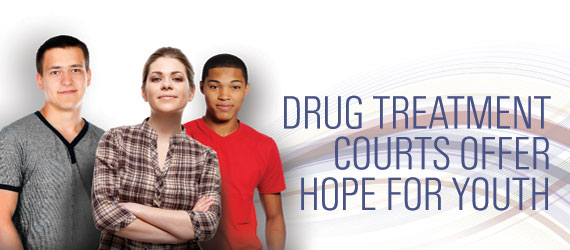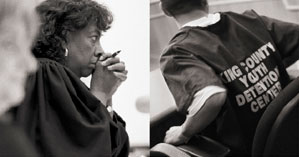
Drug Treatment Courts Offer Hope for Youth
The young Californians served by the Monterey County Health Department's Hope for Youth/Esperanza para los Jóvenes face incredible challenges. Primarily Latino, they live in neighborhoods plagued by gangs, violence, criminal behavior, and easy access to alcohol, marijuana, methamphetamine, cocaine, and other drugs.
After receiving a three-year Juvenile Treatment Drug Court grant from SAMHSA's Center for Substance Abuse Treatment (CSAT) in 2010, the county has been trying to achieve better outcomes for these youth by getting young offenders involved in a juvenile treatment drug court as an alternative to incarceration. Designed to break the cycle of alcohol and drug use, criminal behavior, and incarceration, the project includes alcohol and drug treatment, regular meetings with the judge, and drug testing.
The approach seems to be working. "The trends are moving in the right direction," said project director Theresa Innis-Scimone, M.F.T., of the county's Behavioral Health Bureau. "Fewer young people are relapsing, re-offending, or moving on to a higher level of care," she said. "Plus, more are staying in school and in their communities."
Like Esperanza para los Jóvenes, SAMHSA's other Juvenile Treatment Drug Court grantees are expanding alcohol and drug treatment services in "problem-solving" courts that represent an alternative to incarceration for juvenile offenders. "If a young person with mental, substance use, or co-occurring disorders does get involved with the justice system, we in the behavioral health system have let that young person down," said Larke N. Huang, Ph.D., Director of SAMHSA's Office of Behavioral Health Equity. "They have fallen through the cracks of the behavioral health system and into a system that is not designed to handle mental and substance use disorders."
A Different Model
Juvenile treatment drug courts grew out of the adult treatment drug courts model, which has proven successful in reducing rates of re-offending (see "Incarceration vs. Treatment: Drug Courts Help Substance Abusing Offenders  ," SAMHSA News, March/April 2006). But juvenile treatment drug courts have some important differences from their adult-oriented counterparts.
," SAMHSA News, March/April 2006). But juvenile treatment drug courts have some important differences from their adult-oriented counterparts.
"Originally, after the creation of adult drug courts, juvenile drug courts were created by simply taking their central elements and dropping them into the juvenile justice system," said Kenneth W. Robertson, team leader of the Criminal Justice Grants in CSAT's Division of Services Improvement. "That just doesn't work as the two justice systems have very different goals, approaches, and resources."
There are also some major developmental differences between adolescents and adults. "From a neurodevelopmental standpoint, there are vast differences in brain activity, including judgment and impulse control, in individuals under 25 and adults who are older," said Mr. Robertson.
In addition, he said, adolescents' substance use and criminality typically aren't as firmly entrenched as they are in many older offenders. Unlike adult drug courts, few participants have committed multiple serious offenses, for instance.
That's one reason juvenile treatment drug courts focus so heavily on family engagement, coordination with the school system, and partnerships with community organizations that can help expand the opportunities available to young people and their families.
Other key elements of juvenile drug courts include collaborative, interdisciplinary planning with youth, families, and drug court teams; frequent judicial reviews; drug testing; and incentives and sanctions designed to reinforce good behavior and modify bad.

Seattle, WA: Judges in the juvenile drug court program listen to each case and make sure youth understand the charges against them, as well as address concerns of parents and attorneys.
While specialized juvenile treatment mental health courts exist throughout the country, juvenile treatment drug courts often find themselves confronting mental disorders as well.
"Almost two-thirds of youth in the juvenile justice system have co-occurring disorders," said David Morrissette, Ph.D., a senior program manager in the Community Support Programs Branch at SAMHSA's Center for Mental Health Services (CMHS), citing a study by the National Center for Mental Health and Juvenile Justice. "That research has found that up to 70 percent of youth in the juvenile justice system have mental health disorders and more than 60 percent of those also have a substance use disorder."
Whether youth have co-occurring disorders or just substance use problems, juvenile drug courts can help, according to Michael L. Dennis, Ph.D., of Chestnut Health Systems. In a CSAT-funded analysis, he and other researchers found that the juvenile drug court model works.
In a 2012 evaluation examining data from 1,934 young people participating in drug courts at 17 CSAT grantee sites, evaluators found that participants saw a 26 percent increase in the number of days they abstained from alcohol and other drugs between intake and a 1-year follow-up. Participants' scores on a scale measuring emotional problems and difficulties with self-control declined by 16 percent. The average number of crimes reported dropped by half.
According to the evaluation  , a more intensive approach to juvenile treatment drug courts called Reclaiming Futures
, a more intensive approach to juvenile treatment drug courts called Reclaiming Futures  reached youth with more severe problems, provided more services, and did an even better job of increasing abstinence, reducing emotional problems, and reducing criminal behavior.
reached youth with more severe problems, provided more services, and did an even better job of increasing abstinence, reducing emotional problems, and reducing criminal behavior.
Reclaiming Futures, a collaboration among SAMHSA, the U.S. Department of Justice's Office of Juvenile Justice and Delinquency Prevention, and the Robert Wood Johnson Foundation  , provides substance use treatment to youth in the justice system and connects them to positive activities and caring adults. Twenty-nine communities in 17 states have used the model.
, provides substance use treatment to youth in the justice system and connects them to positive activities and caring adults. Twenty-nine communities in 17 states have used the model.
"There are six stages in the model," said SAMHSA Project Officer Holly Rogers, M.A. "These include screening and assessing young people to identify alcohol or substance use problems, coordinating services across agencies, helping kids and families make an initial contact with services, getting them actively engaged in services, and transitioning them out of services and into long-term supports, such as helping relationships and community resources."
Using a team approach and intensive monitoring, judges, probation officers, substance use treatment professionals, and communities create an individualized plan for each young person.
"Whether it's Reclaiming Futures or SAMHSA's Juvenile Treatment Drug Courts," said Dr. Huang, "the goal is the same: to keep young people from moving deeper into the juvenile justice system or into the adult criminal justice system."
For more information, visit Youth Trauma and Justice Resources  .
.
Photos courtesy Robert Wood Johnson Foundation; photographer Susie Fitzgerald.